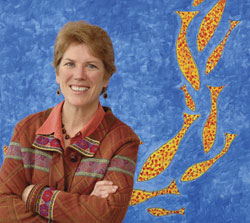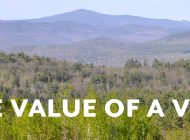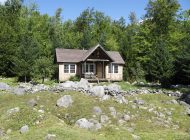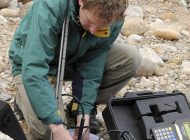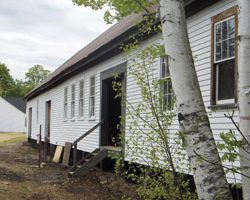Professor of Science Education,
PSU’s Center for the Environment
Mary Ann McGarry’s work takes her (and her students) from the classrooms of PSU to ecological research sites all over the world, including the Galapagos Islands, Costa Rica, and the Four Corners of the U.S. But that’s only part of the reason she loves what she does. Plymouth Magazine recently spoke with McGarry about her career, which blends her loves of environmental science, global community service, research, collaboration, and above all, education.
What drew you to environmental science?
Growing up in Colorado made it easy to love the outdoors. And in high school, my chemistry teacher took us on geology-focused river camping trips, where I discovered the appeal of field-based learning. My undergraduate college, Dartmouth, had a formal connection with Outward Bound, its own ski area, an active kayak and canoe club, and numerous travel-study programs and service learning projects, many with an environmental focus.
You designed your own major as an undergraduate. Why?
I had fabulous instructors in environmental sciences, policy, and geology, and I soon realized my interest in teaching environmental science. Dartmouth didn’t offer a major in environmental education at the time, but it did offer students the option of designing their own majors. So I wrote a proposal for an environmental science education major, but being new to the process, my first application was denied. My next proposal better explained the coherence among my collection of courses and how they would build to a culminating project that involved a student teaching experience, and it was accepted. I received a special commendation for this effort on my transcript, and it’s the accomplishment of which I am most proud from my undergraduate years.
You have been director of education for Hubbard Brook Research Foundation for nearly two years. What does this role entail?
My position at Hubbard Brook Research Foundation (HBRF) is one of the synergistic partnerships established by Steve Kahl, former director of the Center for the Environment. It’s a joint position, and the roles are highly complementary and advantageous for each organization. PSU has access to Hubbard Brook research, education, and resources. HBRF has access to local students and academic resources. One of the foundation’s goals is to use the research that comes out of the Hubbard Brook Ecosystem Study to help secondary educators teach complex environmental issues through classroom activities and outdoor fieldwork. The HBRF education team and I are responsible for translating Hubbard Brook ecosystem science for teachers through professional development opportunities, curriculum development, partnerships with schools, and research experiences.
How does your work with HBRF benefit your work at PSU?
HBRF provides PSU students with real-world research opportunities at Hubbard Brook to which they might not otherwise have easy access. For example, Sara Joncas, who took my Science Methods independent study course, was invited to develop a migratory bird project with me, using more than 40 years of data from Hubbard Brook, some of which was collected by PSU Biology Professor Len Reitsma. We focused on four diverse migratory birds that spend part of the year in New Hampshire forests and part of the year in the tropics. Sara designed, implemented, and evaluated a curricular unit, which will become a teaching guide. She also became involved with the Smithsonian’s Bridging the Americas Migratory Bird Program, a cross-cultural environmental education program. Sara is now student teaching and has been accepted by her first choice for graduate school.
Then there’s the National Science Foundation-funded Research Experience for Undergraduates (REU). This is a highly prestigious grant to run a nationally competitive program during the summer for top undergraduate students. The REU gives students the chance to work with renowned scientists on projects in the major areas of ecosystem research at Hubbard Brook and to live in a field-based research community. The students complete a science translation project for a regional natural resource agency or NGO (non-governmental organization) as well as a science research project. It’s a fabulous opportunity for PSU students.
You have been involved with PSU’s Pakistani Educational Leadership Institute (PELI) for a few years now. What drew you to this program?
When I first came to PSU, I was encouraged to become involved with PELI because I had an interest in and experience with international science education outreach.
During my first year with PELI, we engaged participants in sessions on exploring their watershed. I learned so much from that first PELI experience, and I formed such rich connections with the participants that I was hooked. After the second year, I became involved in helping to write the proposals that fund the program. And I really enjoy the co-teaching opportunities that PELI offers—the team approach to education is not something to which the Pakistanis are accustomed.
Has your involvement with PELI influenced your teaching?
Yes, there’s a tight connection with PELI and my teaching. For example, after the Pakistan earthquake in 2005, the PELI participants had many concerns about earthquake risk assessment and relief efforts. So I asked the undergraduate students in my Hazardous Earth course to design earthquake risk assessment materials to share with the PELI participants. It just made that Hazardous Earth class so much more relevant; the students were contributing resources that would actually be used by people in another country.
One of the students from the class has since returned every summer to assist with PELI. The two of us collaborated to develop a curricular unit on how earthquake risk assessment differs in New Hampshire and Pakistan. We designed and piloted the activities with middle school students, and when the Pakistanis came the following summer, we shared our reflections with them.

Students conducting field research in Costa Rica. Following the tracks of sea turtles to their nests, the students counted and marked nests and looked for signs of poaching by animals or humans.
I like intergenerational learning, and it’s even better when it’s field-based. A rich exchange happens when you mix students who are interested in education with practicing teachers, for example. Probably 25 percent of my travel-study students have been teachers or other working professionals.
What are the benefits of travel-study courses for students?
Travel helps students branch out from a U.S.-centric viewpoint and connect with other cultures. Students learn about other perspectives firsthand and make their own discoveries from dialogue and observations, which produces the richest, most profound growth. There’s no substitute for experiential learning.
Your travel-study courses require students to present their experiences and findings shortly after their return. Why?
The goal is to have the biggest ripple effect possible. Because I’m very sensitive about the high cost of travel, not to mention the size of our carbon footprint, I prompt the students to find ways to extend the experience. They are required to reflect on and share their experiences and learning with others. If possible, students engage in service learning, adding value to the people and places we visit. A science museum educator from Maine who participated in my first travel-study trip to collect data on green sea turtles found this component so valuable that she said she would never travel as “just a tourist” again. She felt like she gave something back to the communities we visited.

McGarry and her students explored the unique geology on Devil's Garden Trail in Arches National Park as part of the Colorado Plateau travel-study course.
This year, the students who traveled to the Four Corners region of Colorado, Utah, Arizona, and New Mexico over spring break were invited to write the cover article for an environmental educational newsletter, whose readership includes 96 school districts on the Colorado plateau. This is truly an authentic writing-across-the-curriculum exercise. The students collaborated to create a meaningful article about visiting diverse cultural and geologic areas and helping to implement a bio-regional ethic in regional schools through activities they presented.
What do you appreciate most about PSU?
PSU values and encourages interdisciplinary and multi-disciplinary teaching ventures, which reflect how the world really works. It also offers a rich integration of teaching and service that is now evolving into research experiences. The Environmental Science and Policy undergraduate and graduate programs, along with many other engaged departments, centers, and institutes on campus, emphasize making community connections to benefit the region and PSU students. Involving students and external partners in stewardship projects is so rewarding.
Did you know?
Every summer since 2004, PSU’s Pakistani Educational Leadership Institute (PELI) has focused on exposing Pakistani educators to best practices in education and professional development with the goal of improving the quality of teaching and education in Pakistan.
Tags: Center For the Environment CFE Mary Ann McGarry Science Science Education





